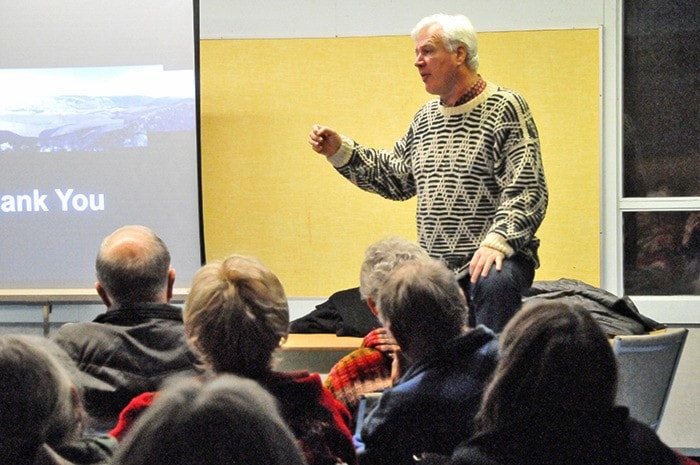Dr. Bruce Archibald was in Ashcroft last week at the invitation of the Village. He spoke about the importance of the McAbee Fossil Beds east of Cache Creek which were given an official heritage designation in 2012. They were also closed to the public at that time.
Archibald has been visiting the site for years, studying in particular the ancient bugs.
“My colleagues travel around the world,” he said. “I work here.”
If you want to find out how our world became modern and how it operates today, the McAbee fossils will help.
The McAbee fossils are 52.88 million years old.
He said there are many fossil sites in the interior because the area was once all high plateau, dotted by lakes and covered by forest, and the sites are ancient.
“I tell people that these sites are like the NHL of fossils and McAbee is Wayne Gretzky.”
The difference is the quality of the fossils at McAbee.
McAbee, he said, is the clearest window of any of these sites into this age (Cenozoic). It nurtured a palm-spruce community with an average temperature of 10 degrees.
The temperature hasn’t changed, he said, but the seasonality has. There was little difference in the seasons 52.8 million years ago, unlike now where the temperatures differ drastically between summer and winter.
He said scientists figured out how to determine paleo climate a century ago by collecting toothed margin leaves and entire margined leaves from a site. The proportion between the two will give you the mean annual temperature for that area, he said.
The amount of plant diversity at McaAbee, he said, would normally be found in a tropical setting, but this is in a temperate one.
Scientists now have a handle on climate change, he said. The fossils at McAbees are so well preserved that you can count the number of stomatas on the leaves. Stomatas regulate carbon dioxide-oxygen exchange. When you compare modern leaf density to these ancient fossils, you can figure out the percentage of carbon dioxide in the air.
“That’s cool!” he said.
Archibald said he’s been studying McAbees for about 20 years. “Once I started looking at it, it became clear to me pretty quickly” how important the site was.
“A big chunk of the site is gone,” he said. “What we’ve got left is precious.”
After a half hour talk, the 60 audience members asked questions for the next hour. Many wanted to know how large the site was. Others wanted to know if the public will ever be allowed back on it.
“This is such a world class resource, it deserves to be treated seriously,” he said. “It should be reburn - in a much better way. People see what they’ve lost and not yet what they will gain. It will be better.”
He noted that many interpretive centres on archaelogical sites have programs for the local population, especially children.
“I hope that there’s still good discoveries there long after I’m gone,” he said. “Stuff coming out of the ground and research being done on properly curated artifacts. There’s still a lot more to come out of the ground.”
